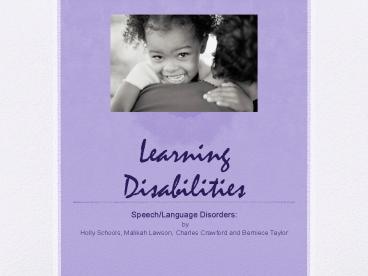Learning Disabilities - PowerPoint PPT Presentation
1 / 17
Title: Learning Disabilities
1
Learning Disabilities
- Speech/Language Disorders
- by
- Holly Schools, Malikah Lawson, Charles Crawford
and Berniece Taylor
2
Speech/Language Disorder What is it?
- Difficulties pronouncing sounds, or articulation
disorders, and stuttering are examples of speech
disorders. - Speech disorders may be problems with the way
sounds are formed, called articulation or
phonological disorders, or they may be
difficulties with the pitch, volume or quality of
the voice.
3
Characteristics of Speech/Language Disorders
- Improper use of words and their meanings.
- Inappropriate grammatical patterns
- Inability to express ideas.
- Inappropriate grammatical patterns.
- Reduced vocabulary.
- Inability to follow directions.
4
Behaviors
- Some children exhibit behaviors that fall outside
of the normal, or expected, range of development.
These behaviors emerge in a way or at a pace that
is different from their peers.
5
Behaviors cont
- Atypical behaviors should be noted and carefully
recorded. They may be isolated events that have
little or no impact on later development. They
might, however, be early warning signs of later
and more significant problems
6
Who are these students?
- Families and teachers should be concerned if a
childs language is noticeably not at the same
level as the language of peers of the same age. - In the Fall of 2003, students aged 3 to 21 that
were being served under Individuals with
Disabilities Education Act (IDEA) Part B numbered
1,460,583, which translates to 5 of the
school-aged population.
7
Who are these students continued
- Studies show that between 28 and 60 of students
with language and/or communication disabilities
have a sibling or parent that also are affected
by language and/or communication disability
(Compiled by Castrogiovanni, 2008). - Most students with language difficulties are
identified before they begin school, however some
students may not be identified until they begin
school (Compiled by Castrogiovanni, 2008).
8
Students continued
- All teachers (both general education and special
education teachers) should be aware of language
and communication disabilities as this is a
problem that we will see and that will, at some
point in time, need to be addressed in our
classrooms.
9
What should parents do?
Early detection of speech/language disorder is
important to getting treatment started early.
Language is known before the child speaks as a
result of the environment they are in. Parents
should talk to their child in regular language as
well as read to their child regularly.
10
What should parents do? cont
- Other activities such as reading books aloud,
singing songs, and encouraging but not forcing
children to interact, is another way parents can
promote speech and language development.
11
What should teachers do?
- Keep lectures clear, simple, pronounced, and in
proper language syntax (no slang) to keep the
attention of the student. Proper eye contact
with the student while listening and speaking
also keeps the student engaged and also allows
the student to participate regularly in the
classroom.
12
Recommendations for teaching
- Dudley-Marling and Searle (1998) identified four
suggestions for working with students who have
language disabilities - (1) the physical setting must promote talk
- (2) the teacher must provide opportunities for
children to interact as they learn - (3) the teacher needs to provide opportunities
for children to use language for a variety of
purposes for a variety of audiences - (4) the teacher needs to respond in ways that
encourage the student to continue the
conversation.
13
Recommendations for teaching contd
- Working in small groups, students can learn to
use context clues to understand difficult words
and learn to ask questions about how the word may
be used (Kuder, 2008). - The ability to communicate and converse with
peers helps open up the communication beyond just
one word answers.
14
Recommendations for identification
- Language disabilities are very difficult to
assess and as educators we must make sure that we
are aware of these difficulties when trying to
identify. - For example with screening, we must keep in mind
that the results tend to over-identify or
under-identify (Kuder, 2008).
15
Recommendations for identification contd
- The best way to identify language issues is to
observe in a classroom setting. - When we watch students converse with their peers,
this will give us the most realistic view of
their communication abilities. - It is important to keep in mind that adolescents
speak differently with their peers, meaning they
are more relaxed, more talkative and more
concerned that their conversation partners
understand what they are staying (Kuder, 2008).
16
Summary
- Almost 1.5 million students are identified as
having language and communication disabilities.
Educators and family members must be aware of the
warning signs of language and communication
disabilities. For the success of children with
language and communication disabilities, early
identification and effective intervention is
imperative.
17
References
- American Speech-Language-Hearing Association
(2005). Helping Children with Communication
Disorders in Schools. Reading Rockets.
Retrieved from http//www.readingrockets.org/artic
le/5128/ - Cazden, C. B. (1986). Classroom discourse. In
M.C. Wittrock (Ed.), Handbook of research on
teaching (pp. 432-464). New York Macmillan - Compiled by Castrogiovanni, A. (2008). Incidence
and Prevalence of Communication Disorders and
Hearing Loss in Children 2008 Edition.
American Speech-Language-Hearing Association.
Retrieved from http//www.asha.org/research/repo
rts/children.htm - Disorders in Children and Adolescents. Retrieved
from http//childdevelopmentinfo.com/child-
psychology/children_with_communication_disorders.s
html - Early Identification Normal and Atypical
Development Retrieved from http//www.ldonline.or
g/article/6047 - Dudley-Marling, C., Searle, D. (1988).
Enriching language learning environments for
students with learning disabilities. Journal of
Learning Disabilities, 21, 140-143. - Kuder, S. J. (2008). Teaching Students with
Language and Communication Disabilities
(272-331). Boston Pearson Education. - NICHY Disability Fact Sheet (2011). Speech and
Language Impairments. National Dissemination
Center for Children with Disabilities.
Retrieved from http//nichcy.org/disability/specif
ic/speechlanguage































